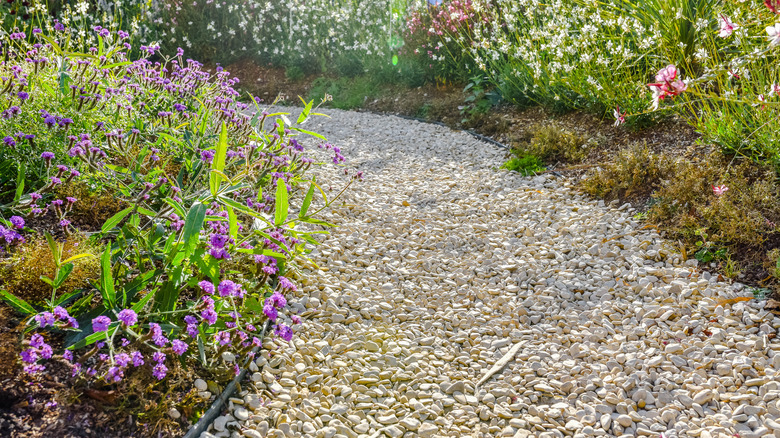The Downside To Choosing Gravel Or Pebbles For Garden Pathways
Gravel and pebbles offer significant benefits when used as garden pathway materials. Not only can they add some visual interest and aesthetic appeal to your property, but they can also increase accessibility, create boundaries, and even help control plant growth and erosion. There are several other reasons why these rocks are among some of the stunning stone walkway ideas to consider as well. For one, the rocks are naturally permeable, allowing water to pass through them easily. In fact, many homeowners use gravel for better landscaping drainage for a variety of projects. Compared to organic mulch, such as straw or bark, using stones for pathways may also be more budget-friendly in the long term because they do not need to be frequently replaced.
Despite all of these advantages, though, gravel and pebbles are not suitable for everyone, and there are some key disadvantages worth knowing. Unlike stepping stones, pavers, and bricks, the sole use of smaller rocks creates a more uneven walking surface. Then there's the fact that both gravel and pebbles come with their own sets of drawbacks. That's why it's important to learn about both the collective and individual downsides of these rocks before considering either a pebble or gravel-based pathway.
The downsides of using gravel or pebbles for garden pathways
When choosing between gravel and pebbles for your garden pathways, much of the decision may come down to aesthetics and your budget. Some people believe pebbles have a more creative and sophisticated appeal thanks to their rounded edges, but they're also more expensive than their gravel counterparts. In addition, they can be cumbersome to walk on because they do not compact as well as gravel. On the other hand, gravel is more affordable and stays compacted a bit better than pebbles. Not everyone likes the rugged appearance of gravel, though.
Moving on to the downsides that both of these stones have in common — gravel and pebbles can move around on pathways, especially with heavy foot traffic. This might not only create tripping hazards but also require you to reposition the rocks from time to time to keep the walkway more stable. On a similar note, be aware that both gravel and pebbles will likely scatter out of the original installation project. This means you'll need to install edging around the pathway to contain them. Finally, pathways made with gravel or pebbles may get hot when exposed to direct sunlight, so it's important to wear gloves and protective clothing if you need to move or touch the stones. Consider using the essential tools for laying gravel and pebbles as another way to stay safe during this type of project.

